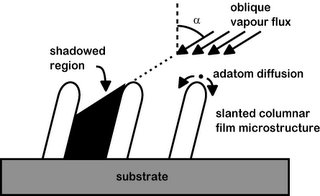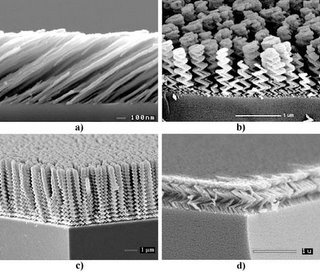Another Puzzle - this time Thin Films Related
Colorized SEM collage with permission of Prof. Michael Brett University of Alberta
CONT'D - click READ MORE.... for the full scoop.
 Glancing Angle Deposition (GLAD) is a technique for fabricating materials with controlled structure. It is based on thin film deposition, by evaporation or sputtering, and employs oblique angle deposition flux and substrate motion to allow nanometer scale control of structure in engineered materials.
Glancing Angle Deposition (GLAD) is a technique for fabricating materials with controlled structure. It is based on thin film deposition, by evaporation or sputtering, and employs oblique angle deposition flux and substrate motion to allow nanometer scale control of structure in engineered materials.The substrate is oriented at a large oblique angle relative to the incident vapour flux (a > 75). This leads to an effect called atomic shadowing and results in a porous structure with isolated columns of material growing toward the vapour source. The substrate is then rotated or tilted during deposition to engineer desired microstructures.

 This figure shows the fundamental techniques used in GLAD with MgF2 films deposited on Si or glass. All 4 films were deposited with the polar flux angle a equal to about 85 degrees. In a), the substrate was held stationary and the flux arrived from the right for the entire deposition. A porous inclined microstructure resulted. In b), the direction of arrival of the flux was alternated from the left and right 12 times during deposition. Note that the polar angle a was kept fixed at 85 degrees for the entire deposition. In c), the substrate was rotated continuously during deposition. The film growth was always toward the vapour source so this resulted in a helical structure. A feedback control system was used to adjust rotation rate to accommodate for varying deposition rate and achieve constant pitch helices. In d), a combination of the techniques used in b) and c) was used. The substrate was rotated in 90 degree steps during deposition. A short pause for deposition followed each 90 degree rotation and the resulting structure is a 4 sided 'square helix'.
This figure shows the fundamental techniques used in GLAD with MgF2 films deposited on Si or glass. All 4 films were deposited with the polar flux angle a equal to about 85 degrees. In a), the substrate was held stationary and the flux arrived from the right for the entire deposition. A porous inclined microstructure resulted. In b), the direction of arrival of the flux was alternated from the left and right 12 times during deposition. Note that the polar angle a was kept fixed at 85 degrees for the entire deposition. In c), the substrate was rotated continuously during deposition. The film growth was always toward the vapour source so this resulted in a helical structure. A feedback control system was used to adjust rotation rate to accommodate for varying deposition rate and achieve constant pitch helices. In d), a combination of the techniques used in b) and c) was used. The substrate was rotated in 90 degree steps during deposition. A short pause for deposition followed each 90 degree rotation and the resulting structure is a 4 sided 'square helix'.wendman nanotechnology electron+beam+evaporation sputtering nano nanotech GLAD glancing+angle+deposition nint alberta+thin+film national+nanotechnology+institute mike+brett kevin+robbie micralyne Chiral+Thin+Films queens+Thin+Films




2 Comments:
OK Mark, it's cheating for me to answer this because Micralyne funded the research and partially own the patents on this. But let's see if anyone else knows.
Chris Lumb
Micralyne Inc.
Hi Chris,
We are working on the issue of relative unknown...(by doing this posting?)
I figure someone might get interested. After all the pictures are quite intriguing, even modestly thought provoking to a decently skilled nano-scientist.
Regards,
Mark
Post a Comment
<< Home